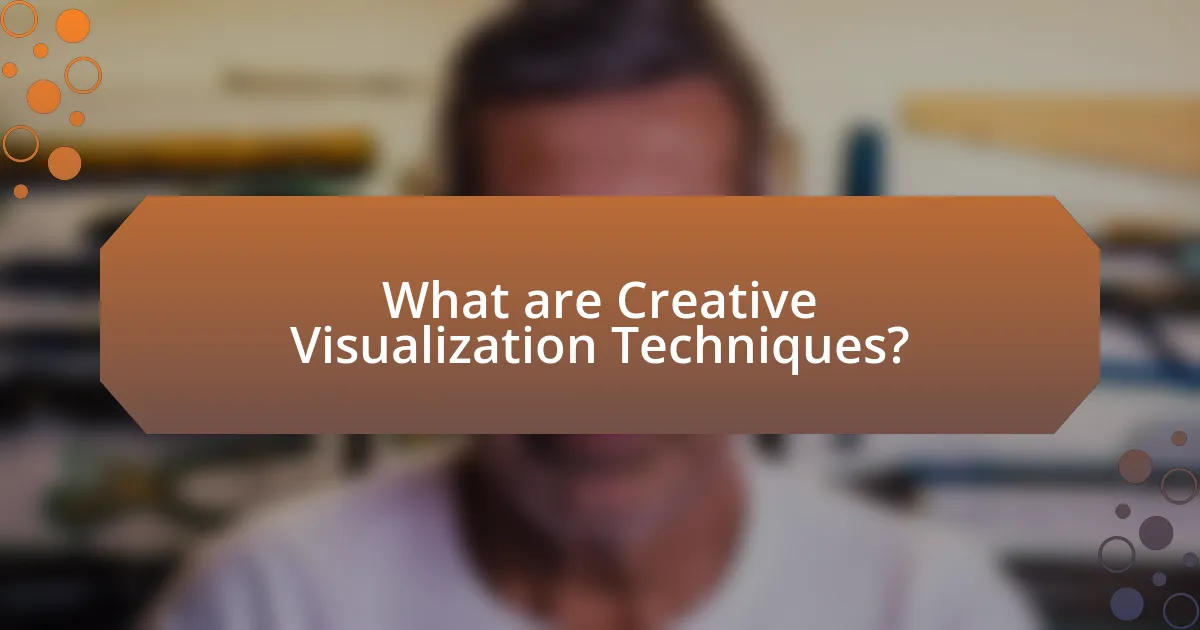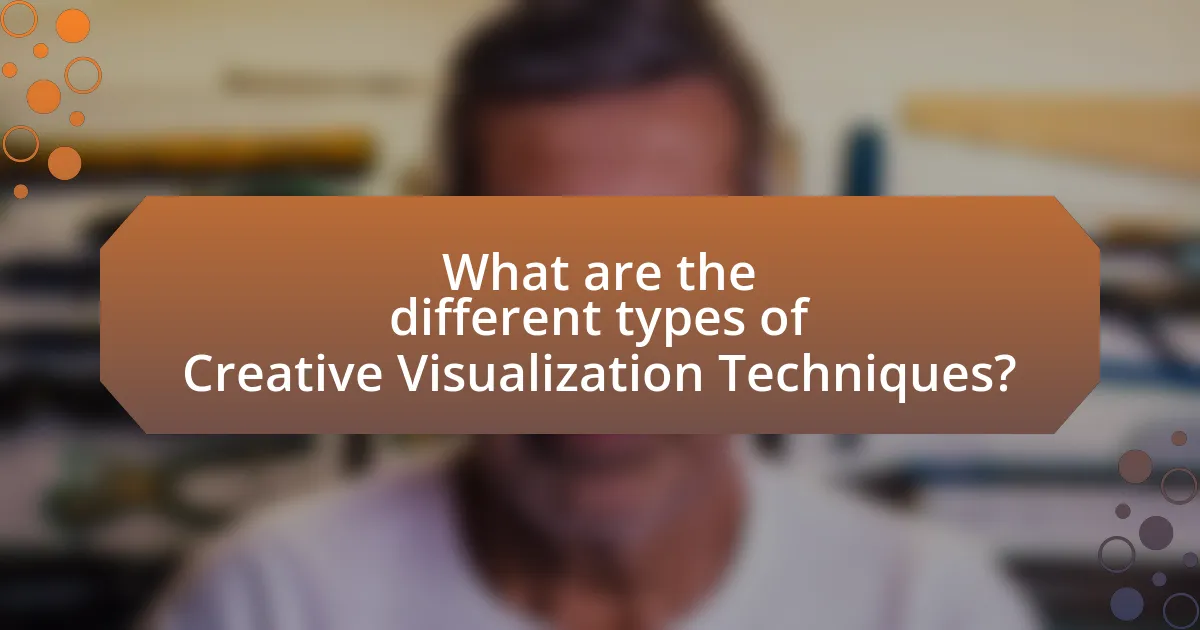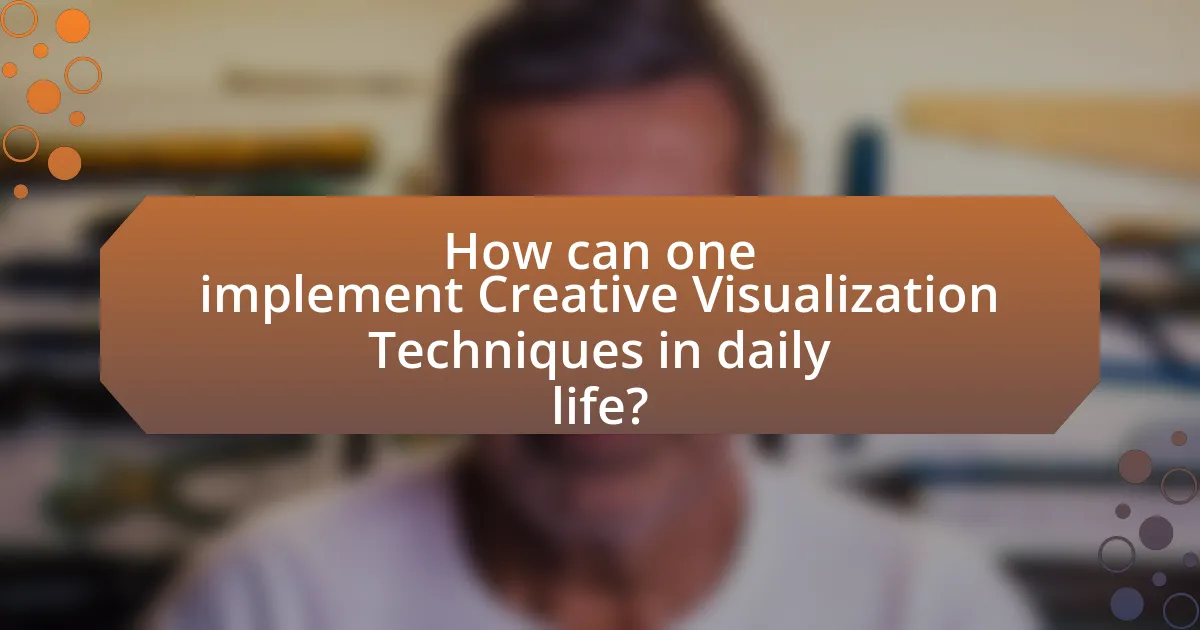Creative visualization techniques are mental practices that utilize imagination to create vivid images or scenarios aimed at achieving specific goals and enhancing performance. These techniques improve focus, motivation, and efficiency by activating neural pathways similar to actual performance, as evidenced by various studies. The article explores how creative visualization enhances concentration, the mental processes involved, and its effectiveness in reducing procrastination and improving productivity. It also discusses different types of visualization techniques, such as guided imagery and affirmations, and provides practical steps for implementing these techniques in daily life to maximize their benefits.

What are Creative Visualization Techniques?
Creative visualization techniques are mental practices that involve using imagination to create vivid images or scenarios in order to achieve specific goals or enhance performance. These techniques leverage the brain’s ability to visualize outcomes, which can lead to improved focus, motivation, and efficiency in various tasks. Research indicates that visualization can activate similar neural pathways as actual performance, thereby reinforcing skills and boosting confidence. For instance, a study published in the Journal of Sports Sciences demonstrated that athletes who engaged in visualization experienced enhanced performance compared to those who did not.
How do Creative Visualization Techniques enhance focus?
Creative visualization techniques enhance focus by enabling individuals to mentally simulate desired outcomes, thereby increasing concentration on specific goals. This mental rehearsal activates neural pathways associated with the actual performance of tasks, which can lead to improved attention and reduced distractions. Research indicates that visualization can enhance cognitive performance; for instance, a study published in the Journal of Applied Sport Psychology found that athletes who practiced visualization techniques showed significant improvements in focus and performance metrics compared to those who did not.
What mental processes are involved in Creative Visualization?
Creative Visualization involves several key mental processes, including imagination, concentration, and emotional engagement. Imagination allows individuals to create vivid mental images of desired outcomes, while concentration focuses attention on these images to enhance clarity and detail. Emotional engagement connects feelings to the visualized scenarios, reinforcing motivation and belief in achieving the desired results. Research indicates that these processes can activate neural pathways associated with goal achievement, thereby increasing the likelihood of success in real-life situations.
How does imagery impact concentration levels?
Imagery significantly enhances concentration levels by engaging the mind in focused visualization, which can improve attention and cognitive performance. Research indicates that mental imagery activates similar neural pathways as actual experiences, thereby sharpening focus and reducing distractions. For instance, a study published in the Journal of Experimental Psychology found that participants who practiced imagery techniques showed a 20% increase in task performance compared to those who did not use such techniques. This demonstrates that effective use of imagery can lead to improved concentration and overall efficiency in tasks requiring sustained attention.
Why are Creative Visualization Techniques effective for efficiency?
Creative Visualization Techniques are effective for efficiency because they enhance focus and clarity of goals. By mentally picturing desired outcomes, individuals can align their actions with their objectives, leading to improved performance. Research indicates that visualization activates the same neural pathways as actual performance, which can enhance motivation and reduce anxiety, thereby increasing overall efficiency. For example, a study published in the Journal of Applied Sport Psychology by Cumming and Williams (2012) found that athletes who used visualization techniques showed significant improvements in their performance metrics compared to those who did not. This demonstrates that Creative Visualization Techniques can effectively streamline processes and boost productivity.
What role does imagination play in improving productivity?
Imagination significantly enhances productivity by enabling individuals to visualize goals and solutions, which fosters creativity and motivation. When people engage their imagination, they can mentally simulate various scenarios, leading to innovative problem-solving and more effective planning. Research indicates that visualization techniques, such as mental imagery, can improve performance in tasks by up to 20%, as demonstrated in studies by Dr. Richard Wiseman, which show that imagining success can increase actual achievement. This cognitive process not only boosts focus but also helps in overcoming obstacles, ultimately leading to higher productivity levels.
How can visualization reduce procrastination?
Visualization can reduce procrastination by creating a mental image of completing tasks, which enhances motivation and focus. When individuals visualize themselves successfully finishing a project, they activate the same neural pathways as if they were actually performing the task, making it feel more achievable. Research by Dr. Richard Wiseman indicates that visualization can increase the likelihood of goal achievement by 70%. This mental rehearsal not only clarifies the steps needed to complete tasks but also reduces anxiety associated with starting them, leading to increased productivity and decreased procrastination.

What are the different types of Creative Visualization Techniques?
The different types of Creative Visualization Techniques include guided imagery, vision boards, mental rehearsal, and affirmations. Guided imagery involves visualizing specific scenarios to achieve desired outcomes, often used in therapeutic settings to reduce anxiety and enhance performance. Vision boards are physical or digital collages that represent goals and aspirations, serving as a constant visual reminder of what one aims to achieve. Mental rehearsal entails vividly imagining oneself performing a task successfully, which has been shown to improve actual performance in various fields, including sports and public speaking. Affirmations involve repeating positive statements to reinforce self-belief and motivation, contributing to a more focused mindset. Each technique has been supported by psychological research, demonstrating their effectiveness in enhancing focus and efficiency.
How can guided imagery be utilized for focus?
Guided imagery can be utilized for focus by creating mental visualizations that enhance concentration and clarity. This technique involves individuals imagining specific scenarios or environments that promote a sense of calm and focus, which can lead to improved cognitive performance. Research indicates that guided imagery can activate brain regions associated with attention and focus, thereby enhancing mental clarity and reducing distractions. For instance, a study published in the Journal of Clinical Psychology found that participants who practiced guided imagery reported increased focus and reduced anxiety levels, demonstrating its effectiveness in enhancing concentration.
What steps are involved in practicing guided imagery?
Practicing guided imagery involves several key steps. First, find a quiet and comfortable space where distractions are minimized. Next, close your eyes and take deep, calming breaths to relax your body and mind. Then, visualize a peaceful scene or a specific goal you wish to achieve, engaging all your senses to create a vivid mental image. After establishing the imagery, maintain focus on the scene or goal for several minutes, allowing yourself to fully experience the emotions associated with it. Finally, gradually bring your awareness back to the present moment, opening your eyes and reflecting on the experience. These steps are supported by research indicating that guided imagery can enhance relaxation and improve focus, making it an effective technique for achieving personal and professional goals.
What are the benefits of using guided imagery for concentration?
Guided imagery enhances concentration by promoting mental clarity and reducing distractions. This technique allows individuals to visualize specific scenarios or outcomes, which can lead to improved focus on tasks. Research indicates that guided imagery can activate brain regions associated with attention and cognitive control, thereby increasing the ability to concentrate. For instance, a study published in the journal “Psychological Science” found that participants who engaged in guided imagery exercises demonstrated better performance on attention-related tasks compared to those who did not. This evidence supports the effectiveness of guided imagery in fostering concentration.
What is the role of affirmations in Creative Visualization?
Affirmations play a crucial role in Creative Visualization by reinforcing positive beliefs and intentions, which enhances the effectiveness of the visualization process. When individuals use affirmations, they create a mental framework that aligns their subconscious mind with their desired outcomes, making it easier to manifest those outcomes through focused visualization. Research indicates that affirmations can lead to improved self-efficacy and motivation, which are essential for achieving goals. For example, a study published in the journal “Psychological Science” by Cohen and Sherman (2014) found that self-affirmation can buffer against stress and improve problem-solving abilities, thereby supporting the overall effectiveness of Creative Visualization techniques.
How do affirmations support focus and efficiency?
Affirmations support focus and efficiency by reinforcing positive beliefs and reducing mental distractions. When individuals regularly practice affirmations, they create a mental environment conducive to concentration, which enhances their ability to stay on task. Research indicates that positive self-affirmations can lead to improved cognitive performance and increased motivation, as demonstrated in a study published in the journal “Psychological Science” by Cohen and Sherman (2014), which found that self-affirmation can mitigate stress and improve problem-solving abilities. This mental clarity and reduced anxiety directly contribute to heightened focus and efficiency in various tasks.
What are some effective affirmation examples for productivity?
Effective affirmation examples for productivity include statements such as “I am focused and efficient in my work,” “I prioritize my tasks and accomplish them with ease,” and “I am capable of achieving my goals.” These affirmations reinforce a positive mindset and enhance motivation. Research indicates that positive affirmations can improve self-efficacy and reduce stress, leading to increased productivity. For instance, a study published in the Journal of Personality and Social Psychology found that self-affirmation can enhance problem-solving abilities and performance under pressure.

How can one implement Creative Visualization Techniques in daily life?
To implement Creative Visualization Techniques in daily life, one should regularly practice mental imagery by vividly imagining desired outcomes and experiences. This can be achieved by setting aside a few minutes each day to close the eyes, relax, and visualize specific goals, such as achieving success in a project or enhancing personal relationships. Research indicates that visualization can activate similar brain regions as actual experiences, thereby improving performance and focus (Driskell, Copper, & Moran, 1994, Journal of Applied Psychology). By consistently engaging in this practice, individuals can enhance their motivation and clarity, leading to increased efficiency in their daily tasks.
What are practical steps to start using Creative Visualization?
To start using Creative Visualization, begin by clearly defining your goals and desired outcomes. This involves writing down specific objectives you wish to achieve, such as improving focus or enhancing efficiency in tasks. Next, create a quiet and comfortable space where you can relax and concentrate. During visualization sessions, close your eyes and imagine yourself successfully achieving your goals, incorporating as many sensory details as possible to make the experience vivid. Regular practice is essential; aim for daily sessions of 10 to 15 minutes to reinforce the mental imagery. Research indicates that consistent visualization can lead to improved performance and motivation, as evidenced by studies showing that athletes who visualize their success often perform better in competitions.
How can one create a visualization routine?
To create a visualization routine, one should establish a consistent practice that incorporates specific techniques for mental imagery. This involves setting aside dedicated time each day to engage in visualization exercises, such as imagining achieving personal or professional goals, which can enhance focus and efficiency. Research indicates that regular visualization can improve performance and motivation, as evidenced by a study published in the Journal of Applied Sport Psychology, where athletes who practiced visualization techniques showed significant improvements in their performance metrics.
What tools or resources can aid in practicing visualization?
Meditation apps such as Headspace and Calm can aid in practicing visualization by providing guided sessions that enhance mental imagery skills. These apps often include specific visualization exercises designed to improve focus and relaxation, which are essential for effective creative visualization. Research indicates that regular use of such tools can lead to improved cognitive function and stress reduction, thereby reinforcing the practice of visualization techniques.
What common challenges might arise when using Creative Visualization?
Common challenges that might arise when using Creative Visualization include difficulty in maintaining focus, skepticism about effectiveness, and the potential for negative imagery. Individuals often struggle to concentrate on their visualizations due to distractions or a wandering mind, which can hinder the process. Research indicates that skepticism can lead to a lack of belief in the technique’s efficacy, reducing motivation and commitment to practice. Additionally, if individuals inadvertently visualize negative outcomes, it can create anxiety and counteract the intended positive effects of the practice. These challenges can impede the overall effectiveness of Creative Visualization techniques.
How can one overcome skepticism about visualization techniques?
To overcome skepticism about visualization techniques, one can engage in practical experimentation by applying these techniques in real-life scenarios. Research indicates that individuals who practice visualization report improved performance in various tasks, such as sports and public speaking, due to enhanced mental rehearsal (Cumming & Williams, 2012, Journal of Applied Sport Psychology). By setting specific goals and tracking progress, skeptics can observe tangible results that validate the effectiveness of visualization. Additionally, studying testimonials and scientific literature on the benefits of visualization can further reinforce its credibility and encourage a more open mindset towards its application.
What strategies can help maintain focus during visualization practice?
To maintain focus during visualization practice, individuals can employ strategies such as setting a clear intention, minimizing distractions, and using guided imagery. Setting a clear intention helps define the purpose of the visualization, which can enhance concentration. Minimizing distractions involves creating a quiet environment and turning off electronic devices, allowing for deeper engagement in the practice. Using guided imagery, such as audio recordings or scripts, can provide structure and keep the mind focused on the visualization process. Research indicates that structured visualization techniques can improve cognitive performance and focus, as evidenced by studies showing enhanced task performance in individuals who engage in focused visualization exercises.
What are some best practices for maximizing the effectiveness of Creative Visualization Techniques?
To maximize the effectiveness of Creative Visualization Techniques, individuals should engage in regular practice, maintain clarity of goals, and incorporate sensory details into their visualizations. Regular practice enhances familiarity and comfort with the technique, leading to improved outcomes. Clarity of goals ensures that the visualization is focused and directed, which research indicates increases motivation and commitment (Locke & Latham, 2002). Incorporating sensory details, such as sights, sounds, and feelings, makes the visualization more vivid and engaging, which can enhance emotional connection and retention of the desired outcome.
How can one tailor visualization techniques to personal goals?
One can tailor visualization techniques to personal goals by clearly defining those goals and using specific imagery that aligns with them. For instance, if an individual aims to improve public speaking skills, they should visualize themselves confidently delivering a speech in front of an audience, incorporating sensory details such as the sound of applause and the feeling of success. Research indicates that visualization can enhance performance; a study published in the Journal of Applied Sport Psychology found that athletes who practiced visualization techniques improved their performance by up to 20%. By consistently practicing this tailored visualization, individuals can reinforce their commitment to their goals and enhance their focus and efficiency in achieving them.
What tips can enhance the overall experience of Creative Visualization?
To enhance the overall experience of Creative Visualization, practitioners should incorporate clarity of intention, sensory engagement, and regular practice. Clarity of intention involves defining specific goals or outcomes, which helps focus the visualization process and increases its effectiveness. Sensory engagement means vividly imagining the sights, sounds, and feelings associated with the desired outcome, as research indicates that multisensory experiences can significantly enhance mental imagery (Kosslyn et al., 2001). Regular practice solidifies the habit of visualization, making it more effective over time; studies show that consistent mental rehearsal can improve performance in various tasks (Driskell et al., 1994).
